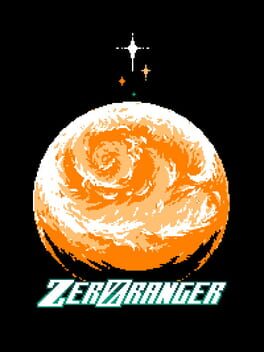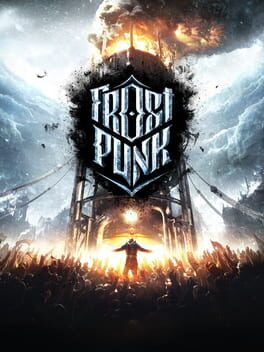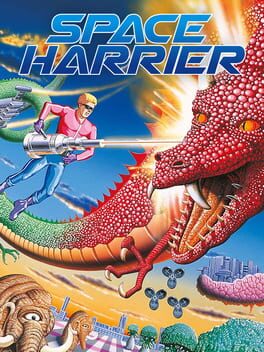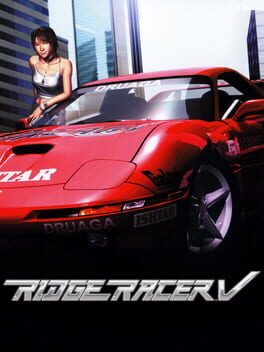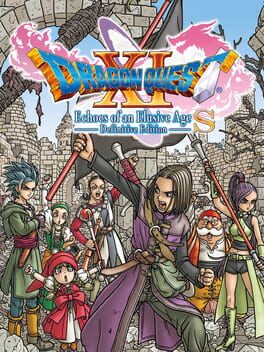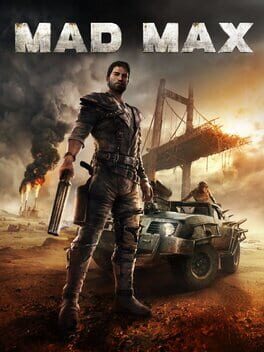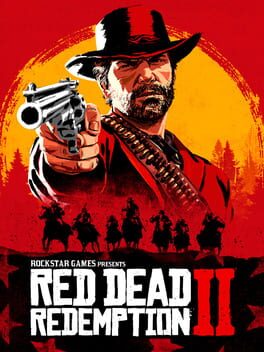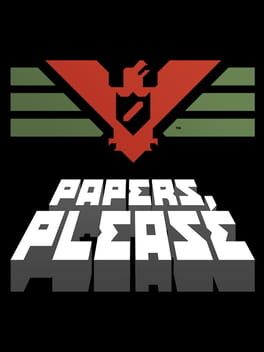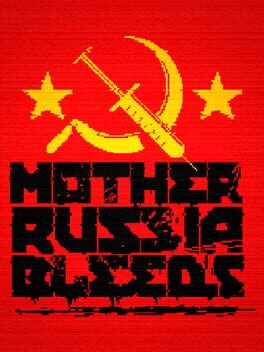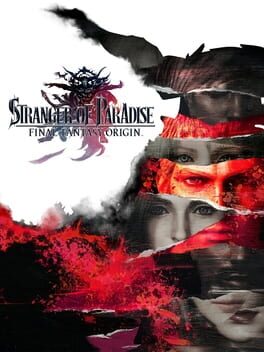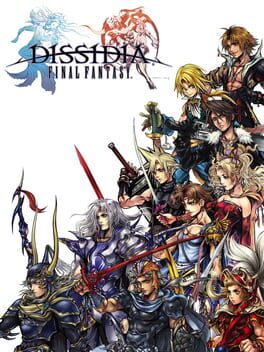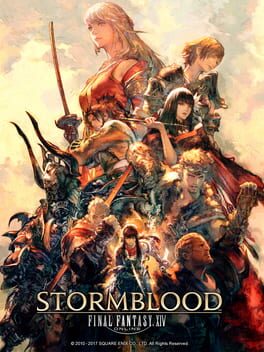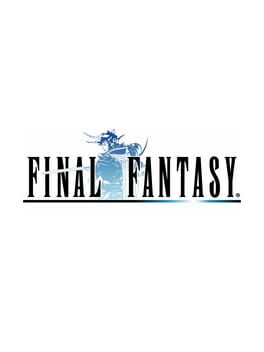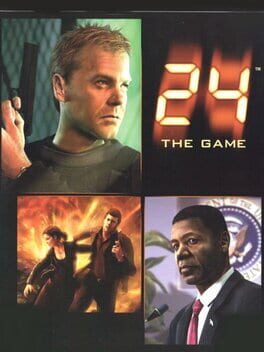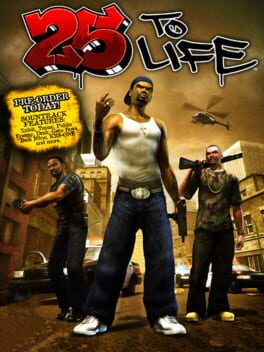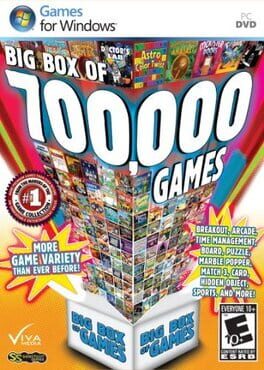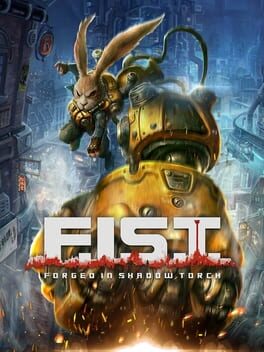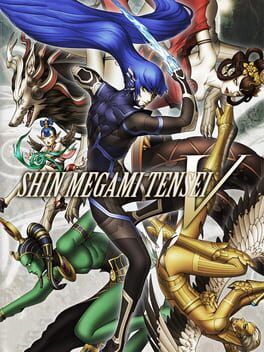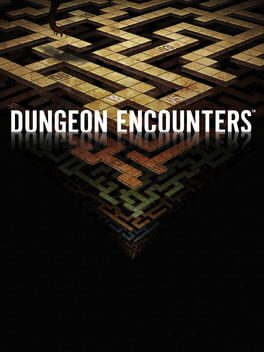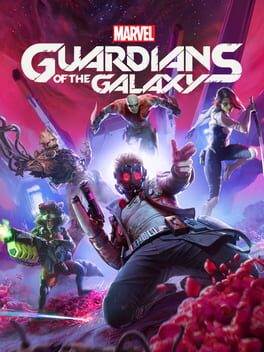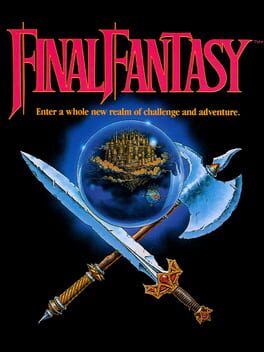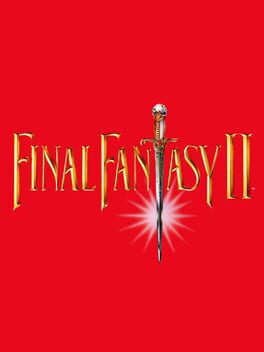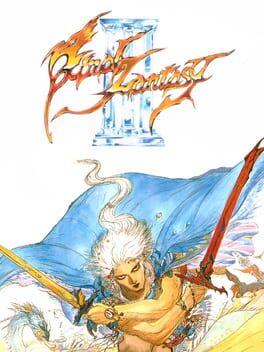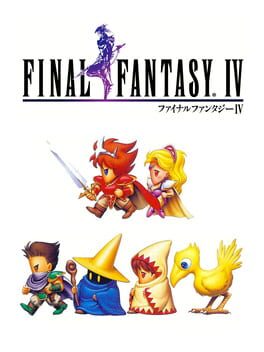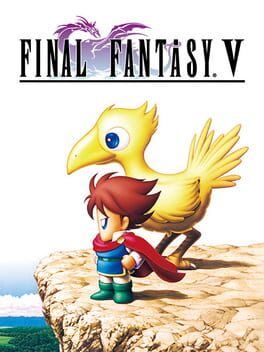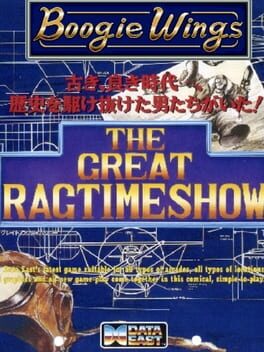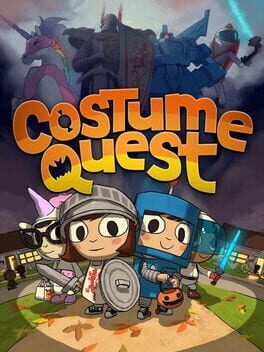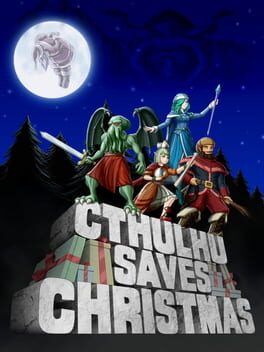Capitoro
53 reviews liked by Capitoro
Castlevania
1986
Scorn
2022
GuessTheGame
2022
It's pretty cool to be choosing stats at random until you finally get a fucking date, then you get to go to the park with your waifu and the game says "nah, skip that ferris wheel shit, go back to the numbers screen again". It truly does have charisma and I want to marry the cool blue haired girl, it would be game of the century if the game was about that and not about playing the same three years 3991 times to get the full waifu collection and like 30 cool moments in between.
Noo but the Tim Rogers... Shut up! I'm not watching that! In 6 hours I can find, meet, get to know and bang a real girl, leave me alone! The guy, like tokimeki, just says about one or two interesting things between the most decorated prose that has so many turnarounds that vndbcore renowed authors would be envious. Prestige spanish streamer alexelcapo brings up more interesting, concise and honest thoughts at this point. The stories are cool right. You know who tells cool stories too? Your grandpas, go visit them before it's too late!. Oh no, but they make up the stories! Do you think old friend timmy really did become a power ranger gigolo when he was living in akihabara or wherever in otakuland? Not to blame him! Making things up right is the way of life, I like to do that myself quite a bit.
See, I lost the point just like tokimeki gets lost in boring ass numbers. I hope that tokimeki girls and gays side gets better. I heard its more casualized which in normal people language means less bullshit system and more action with the guys and girls. Thank god!
Noo but the Tim Rogers... Shut up! I'm not watching that! In 6 hours I can find, meet, get to know and bang a real girl, leave me alone! The guy, like tokimeki, just says about one or two interesting things between the most decorated prose that has so many turnarounds that vndbcore renowed authors would be envious. Prestige spanish streamer alexelcapo brings up more interesting, concise and honest thoughts at this point. The stories are cool right. You know who tells cool stories too? Your grandpas, go visit them before it's too late!. Oh no, but they make up the stories! Do you think old friend timmy really did become a power ranger gigolo when he was living in akihabara or wherever in otakuland? Not to blame him! Making things up right is the way of life, I like to do that myself quite a bit.
See, I lost the point just like tokimeki gets lost in boring ass numbers. I hope that tokimeki girls and gays side gets better. I heard its more casualized which in normal people language means less bullshit system and more action with the guys and girls. Thank god!
ZeroRanger
2018
Se você começar uma nova partida de ZeroRanger e matar as ondas iniciais de inimigos perfeitamente, uma coisa bem bacana acontece. Quanto mais inimigos você mata em sequência, mais cresce seu multiplicador de pontuação. Se você não errar o alvo nenhuma vez na introdução, vai atingir o multiplicador máximo ao mesmo momento em que as luzes da cidade futurística ao fundo começam a acender. Nesse exato momento, como que motivado pela mudança de cenário, uma voz eletrônica ressoa "MAXIMUM" e a música do jogo começa a ficar mais animada. Tudo isso ocorre nos primeiros 20 segundos iniciais do jogo. 20 segundos. Esse foi o tempo necessário para eu me apaixonar por ZeroRanger.
Toda a sincronia da música, cinética e imagens desses segundos iniciais, a forma como essa cena é cuidadosamente montada para acionar todos os seus sensores de endorfina simultaneamente, me fez na mesma hora pensar "esse é um excelente shmup!" Mas logo comecei a pensar se eu realmente podia dizer isso. Que eu estava lidando com um excelente jogo eu não tinha muitas dúvidas, mas com que autoridade eu poderia dizer que ele era um excelente shmup? Discussões sobre "é um bom jogo mas mau X" raramente têm meu interesse porque costumam ser apenas um subterfúgio para tentar se criticar ou diminuir uma obra sem ofender seus fãs. Minha intenção não é fazer isso com ZeroRanger de forma alguma. Antes, o que estou colocando na balança não são as credenciais do jogo como representante do gênero de shmup, e sim as minhas credenciais como jogador. Afinal, se eu classificar um jogo como um dos melhores de sua categoria, presume-se que eu tenha uma familiaridade razoável com a categoria em questão.
Vejam bem, eu sou um apreciador de shmups, mas dificilmente me consideraria um fã. Eu joguei vários games do gênero, incluindo algumas das principais franquias clássicas como Gradius e Darius, mas nunca me aprofundei o suficiente nos jogos para me tornar um jogador razoavelmente competente. O espetáculo audiovisual sempre me atraiu mais do que a experiência desafiadora e a busca pela perfeição, então nunca tive problemas em jogar em dificuldades menores, usar cheats e até rewind para "completar" os games. Coloco aqui aspas em "completar" devido a um aspecto particular desse tipo de jogo, considerado uma lei universal no fandom e às vezes enforçado nos próprios games: um jogo só é considerado verdadeiramente zerado após se concluir uma "1cc", ou "one-credit clear"; jogar do início ao fim sem usar nenhum continue (ou seja, usando só uma ficha) e, obviamente, nenhuma trapaça. Seguindo esse critério o número de shmups que verdadeiramente zerei não é digno de comentários.
Dito isso, eu diria que joguei, ou pelo menos experimentei uma diversidade o suficiente de jogos de navinha na minha vida para poder divagar um pouco sobre o que eles têm de tão sedutor. E, mesmo que minha compreensão do gênero seja admitidamente superficial, ZeroRanger é tão espetacular que faz com que mesmo com o pouco que eu entendo do gênero eu não tenha medo de dizer: "é, esse é um excelente shmup".
O gênero de de Shoot 'em Up, em seu melhor estado, é expressão máxima da narrativa de Davi contra Golias. Com apenas uma navezinha pequenininha você deve enfrentar um número absurdo de inimigos maiores, mais fortes e que atiram com muito mais frequência. Apesar de haver algum tipo de justificativa narrativa para você ter uma chance miraculosa de sobreviver a missão (normalmente sua nave é alguma espécie de protótipo nunca usado antes capaz de sozinho virar a guerra!), a fragilidade de sua situação é inegável, fragilidade que muitas vezes se manifesta de forma literal no fato de que uma única bala ou colisão pode ser o suficiente para destruir sua nave. Portanto, em vez de uma simples fantasia de empoderamento, shmups são fantasias de superação. Eles te colocam numa situação de extrema desvantagem que só pode ser superada com habilidade e persistência - diferente do caso do rei Davi, intervenções divinas não são muito comuns aqui.
Acontece que esse tipo de fantasia é tão frágil quanto a navinha que você controla. Para ela funcionar, o jogador tem que a todo momento estar com a sensação de que está, de fato, superando algo. O ideal é que desafio esteja sempre um pouquinho além do limite de suas habilidades, o suficiente para ele sentir que evoluiu ao vencer, mas não alto o suficiente para parecer algo injusto ou impossível. Inversamente, se o desafio não é capaz de colocar o jogador no limite, ele será visto como fácil demais ou entendiante. É quando você está na zona limítrofe entre a vida e a morte que o gênero realmente brilha. Jogos de navinha estão sempre tentando buscar esse equilíbrio mágico.
Obviamente, assim como toda mídia interativa, shmups também têm que lidar com o fato de que existem jogadores de diferentes níveis de habilidade. Um jogo em que o desafio está na medida para uma pessoa pode ser fácil ou difícil demais para outra. Isso é algo perfeitamente normal e não exclusivo ao gênero. O que por outro lado é uma peculiaridade dos jogos de navinha é sua fama de falta de acessibilidade. Apesar de existirem STGs mais difíceis e mais fáceis, mais ou menos acessíveis, no discurso público o gênero ganhou a fama de ser exclusivo para os jogadores mais hardcore possíveis. É provável que em sua busca incessante por games que alcançam aquele mítico ponto de equilíbrio entre a vida e a morte os veteranos e devs puxaram as fronteiras do gênero, dando a ele como um todo essa aura de algo inalcançável para novatos. (e, claro, também tem muito circlejerk no fandom)
Andando na contramão dessa tendência, ZeroRanger é (deliberadamente) bem mais acessível que muitos de seus congêneres, quase ao ponto de podermos dizer que é um jogo "fácil" para os padrões da categoria. De fato, numa comparação direta com clássicos famosos como Gradius, a conclusão de que estamos lidando com um jogo bem mais "perdoável" é quase lógica. Por exemplo, sua nave não morre com apenas um tiro: ela começa com um mínimo de 3 de HP, podendo chegar a 5, e tem a chance de recuperar o HP perdido durante as partidas se sua pontuação for alta o suficiente. Colisões com inimigos ou obstáculos, que significam morte sumária em grande parte dos shmups, também tiveram sua punição atenuada, sendo necessário choques repetidos ou muito intensos para lhe causar dano. Se apesar disso tudo você morrer mesmo assim, mais uma vez o jogo lhe dá um empurrãozinho. Apesar de inicialmente você não ter continues, seus pontos acumulados durante a partida enchem uma barra que, quando completa, lhe dão um continue permanente para as próximas partidas. Você pode acumular um total de oito continues assim, um número razoável para você tentar várias vezes e melhorar no jogo sem trivializar tudo com chances infinitas. E, num exemplo final de piedade, você não precisa recomeçar o jogo do zero, podendo selecionar uma nova partida do começo da última fase em que chegou, preservando todos os seus continues e upgrades de armas.
Com tanto generosidade, pode parecer que ZeroRanger só será capaz de colocar naquela zona mágica entre vida e morte, de trazer aquela sensação de constante superação, à pessoas novas no gênero ou não muito experientes. Talvez isso seja mesmo verdade, mas não considero de forma alguma um aspecto negativo. Como um sábio game designer uma vez disse, "é bom lembrarmos que há muito mais crianças e novatos do que gamers". Mas mesmo que seu foco seja novatos, ZeroRanger ainda tenta o levar até esse limite. Ele foge do erro comum de que porque seu público-alvo é mais inexperiente ele deve receber tudo de bandeja. Acessível? Sim. Trivial? De forma alguma.
Vamos reexaminar esses atributos de acessibilidade de ZeroRanger por um momento e ver como os finlandeses da System Erasure implementaram eles sem tornar o jogo trivial.
Primeiramente, o HP. Um limite mínimo de 3 vidas é generoso, mas nada que não tenha sido visto em outros shmups, alguns lendariamente difíceis como DoDonPachi. Além disso, ZeroRanger implementa um sistema sutil sistema de "ranking" que garante que você não se sentirá muito confortável só porque acumulou um pouco de hit points. Quanto maior seu HP e score, mais agressivos os inimigos e rápidas as balas. Seu HP é, portanto, uma forma de puxar os limites do jogo - e quanto mais você os puxa, mais o jogo reage puxando seus limites também.
Os continues também se encaixam nessa mesma lógica de "acessível mas não trivial". Para começar, eles são algo que você conquista, não um mero presente disponível desde o início. Encher a barrinha que te dá continues oito vezes significa que você acumulou um bocado de pontos e, provavelmente, morreu várias vezes em runs variadas. No mais, é preciso salientar que seu número ainda é limitado. Os continues são um recurso duramente conquistado e escasso que, uma vez utilizados, só retornam numa nova partida. Mesmo com oito continues um game over continua sendo uma realidade. Não há mortes impunes neste jogo.
Ademais, como os continues funcionam é algo tão bem planejado quanto a forma de adquirí-los. As duas formas tradicionais de continues funcionarem em shmups é eles te reviverem no exato lugar que você morreu (às vezes sem upgrade algum, então você morrerá imediatamente) ou no início da fase (o que pode ser cansativo se você, por exemplo, está emperrado numa parte no final do estágio e terá que fazer ele todo de novo só pra morrer lá mais uma vez). ZeroRanger tenta, e ouso dizer que consegue, unir o melhor dos dois mundos. Os estágios são divididos em várias seções, compostas por uma onda específica de inimigos - algo que não aparece de forma explícita para o jogador mas ao se familiarizar com o level design você começará a perceber. Quando você morre, você retorna para o início da última seção. Essa abordagem tem duas vantagens enormes. Primeiro, isso impede que você entre num ciclo vicioso de mortes sem fim. Você nunca será revivido no meio de uma chuva de balas ou na frente de trocentos inimigos suicidas. Segundo, isso obriga o jogador a efetivamente vencer aquela determinada seção pelo menos uma vez para prosseguir. Gastar fichas infinitamente e se suicidar sucessivamente para passar de uma parte difícil não é uma estratégia possível aqui. Se você passou de uma parte, mesmo que tenha tentado várias vezes, é porque foi capaz.
Encaixam-se nisso também os upgrades permanentes. Você nunca sentirá que perdeu todas as chances de prosseguir porque perdeu seus upgrades. Em compensação, não é possível acumular armas e tornar sua navinha "overpower". As armas que você ganha são determinadas e, criticamente, muito bem equilibradas. Elas são versáteis e úteis, não projetos de Armagedom. Além disso, como há uma progressão semi-linear para adquirir os upgrades, com cada chefe lhe dando duas opções de armas para adquirir, estágios subsequentes partem do princípio de que podem ser montados com eles em mente, então é melhor você aprender a utilizar suas funções ofensivas e defensivas.
Mais importante do que tentar ser acessível sem trivializar a experiência, ZeroRager também tenta usar sua acessibilidade como um elemento pedagógico sem cair na armadilha de ser condescendente. Veteranos do gênero têm um monte de regras implícitas de como ele funciona, as mais proeminentes sendo a já discutida "1cc" e o foco em adquirir altas pontuações (highscore). A forma como você consegue mais continues em ZeroRanger acaba imbuindo no jogador o mindset de que às vezes é melhor recomeçar do zero do que continuar de onde parou, já que sua pontuação será maior assim e, portanto, você conseguirá encher a barra de continues mais rapidamente. Melhor ainda se o jogador conseguir sobreviver por mais tempo: seu score acumula muito mais rápido quanto mais longe você consegue chegar, então uma única run mais longa pode te dar bem mais pontos (e continues) do que vária runs curtas. Logo você estará num ciclo vicioso, tentando chegar o mais longe possível com apenas uma vida. Sem perceber, e sem a necessidade de que alguém te diga de forma explícita, você estará jogando ZeroRanger do "jeito certo".
Tudo isso culmina no True Final Boss. Quando você pensa que já não tem mais motivos para jogar do "jeito certo", que já adquiriu o máximo de continues e destravou todas as fases, que só lhe resta fazer o último estágio e vencer o chefe final, o jogo mais uma vez lhe dá excelentes motivos para fazer uma 1cc (ou o mais próximo disso) - e, dessa vez, os motivos são mecânicos *e* narrativos.
Há algumas coisas a se considerar em relação a como shmups lidam com a narrativa. Não creio ser exagero dizer que na maioria da cabeça das pessoas esse é um gênero em que elementos narrativos são vistos como secundários, no mínimo. No limite, STGs são vistos como experiências puramente estético-mecânicas por alguns, algo muito próximo do gênero de twitch. Talvez isso seja pelo fato de eles serem um dos primeiros gêneros de games a se consolidarem e por isso mantém essa aura da pureza mecânica ou pelo menos de uma precedência da gameplay ante ao narrativo. Entretanto, mesmo um conhecimento mais superficial do gênero vai te fazer perceber que isso é apenas um estereótipo... Mas como muitos estereótipos perniciosos, ele não rejeita a realidade, apenas a exagera. Sim, muitos shmups têm uma narrativa que fica muito mais implícita e é possível apreciar vários shmups sem prestar atenção a história. Mas eu diria que o mesmo se aplica a gêneros que são vistos como primariamente narrativos ou narrativos por excelência - você, companheiro latino-americano que não falava inglês quando criança e mesmo assim jogava RPGs, sabe que é possível apreciá-los através de aspectos visuais e mecânicos, mesmo que as particularidades da história não sejam capazes de superar a barreira linguística.
ZeroRanger ter uma narrativa encorpada e nada genérica não é nenhuma forma de ineditismo, portanto. Mas os usos que o jogo faz de sua narrativa são, se não únicos (uma palavra que sempre sou temerário em utilizar), muito interessantes em como complementam e se integram aos outros aspectos do jogo. Os devs tiveram uma incrível epifania de usar como seu tema mitos e aspectos das religiões indianas, em especial o conceito de Samsara. Se por acidente ou intenção, só posso dizer que fazer isso foi genial.
Samsara é o eterno ciclo de nascimento, morte e renascimento através dos mundos que rege a cosmologia de várias tradições filosófico-religiosas do leste asiático. Especialmente na perspectiva budista, esse ciclo é doloroso. Com o tempo sua alma se apega à sua vida terrena, apenas para sofrer com doenças, desapontamentos e, por fim, morte - e então recomeçar o ciclo de apego, sofrimento e morte mais uma vez. Os paralelos com a experiência num shump são fáceis de fazer. A medida que você vai mais longe, mata mais chefes, consegue pontuações maiores, cresce seu apego à "vida", sua vontade de vencer, só para uma bala aleatória lhe fazer perder tudo. Começa então um novo ciclo de vida e morte, aparentemente infindável.
Mas é possível escapar desse ciclo. Para as religiões indianas, a única forma de escape é através do acúmulo de perfeita sabedoria, karma e desapego material através de muitas e muitas vidas. Em ZeroRanger, a solução é mais simples: através da persistência. Se cada ciclo traz consigo mais uma vez a perspectiva de novo sofrimento, ele também te traz a certeza de que você está melhorando e superando seus limites.
Que você possa atingir a iluminação.
Toda a sincronia da música, cinética e imagens desses segundos iniciais, a forma como essa cena é cuidadosamente montada para acionar todos os seus sensores de endorfina simultaneamente, me fez na mesma hora pensar "esse é um excelente shmup!" Mas logo comecei a pensar se eu realmente podia dizer isso. Que eu estava lidando com um excelente jogo eu não tinha muitas dúvidas, mas com que autoridade eu poderia dizer que ele era um excelente shmup? Discussões sobre "é um bom jogo mas mau X" raramente têm meu interesse porque costumam ser apenas um subterfúgio para tentar se criticar ou diminuir uma obra sem ofender seus fãs. Minha intenção não é fazer isso com ZeroRanger de forma alguma. Antes, o que estou colocando na balança não são as credenciais do jogo como representante do gênero de shmup, e sim as minhas credenciais como jogador. Afinal, se eu classificar um jogo como um dos melhores de sua categoria, presume-se que eu tenha uma familiaridade razoável com a categoria em questão.
Vejam bem, eu sou um apreciador de shmups, mas dificilmente me consideraria um fã. Eu joguei vários games do gênero, incluindo algumas das principais franquias clássicas como Gradius e Darius, mas nunca me aprofundei o suficiente nos jogos para me tornar um jogador razoavelmente competente. O espetáculo audiovisual sempre me atraiu mais do que a experiência desafiadora e a busca pela perfeição, então nunca tive problemas em jogar em dificuldades menores, usar cheats e até rewind para "completar" os games. Coloco aqui aspas em "completar" devido a um aspecto particular desse tipo de jogo, considerado uma lei universal no fandom e às vezes enforçado nos próprios games: um jogo só é considerado verdadeiramente zerado após se concluir uma "1cc", ou "one-credit clear"; jogar do início ao fim sem usar nenhum continue (ou seja, usando só uma ficha) e, obviamente, nenhuma trapaça. Seguindo esse critério o número de shmups que verdadeiramente zerei não é digno de comentários.
Dito isso, eu diria que joguei, ou pelo menos experimentei uma diversidade o suficiente de jogos de navinha na minha vida para poder divagar um pouco sobre o que eles têm de tão sedutor. E, mesmo que minha compreensão do gênero seja admitidamente superficial, ZeroRanger é tão espetacular que faz com que mesmo com o pouco que eu entendo do gênero eu não tenha medo de dizer: "é, esse é um excelente shmup".
O gênero de de Shoot 'em Up, em seu melhor estado, é expressão máxima da narrativa de Davi contra Golias. Com apenas uma navezinha pequenininha você deve enfrentar um número absurdo de inimigos maiores, mais fortes e que atiram com muito mais frequência. Apesar de haver algum tipo de justificativa narrativa para você ter uma chance miraculosa de sobreviver a missão (normalmente sua nave é alguma espécie de protótipo nunca usado antes capaz de sozinho virar a guerra!), a fragilidade de sua situação é inegável, fragilidade que muitas vezes se manifesta de forma literal no fato de que uma única bala ou colisão pode ser o suficiente para destruir sua nave. Portanto, em vez de uma simples fantasia de empoderamento, shmups são fantasias de superação. Eles te colocam numa situação de extrema desvantagem que só pode ser superada com habilidade e persistência - diferente do caso do rei Davi, intervenções divinas não são muito comuns aqui.
Acontece que esse tipo de fantasia é tão frágil quanto a navinha que você controla. Para ela funcionar, o jogador tem que a todo momento estar com a sensação de que está, de fato, superando algo. O ideal é que desafio esteja sempre um pouquinho além do limite de suas habilidades, o suficiente para ele sentir que evoluiu ao vencer, mas não alto o suficiente para parecer algo injusto ou impossível. Inversamente, se o desafio não é capaz de colocar o jogador no limite, ele será visto como fácil demais ou entendiante. É quando você está na zona limítrofe entre a vida e a morte que o gênero realmente brilha. Jogos de navinha estão sempre tentando buscar esse equilíbrio mágico.
Obviamente, assim como toda mídia interativa, shmups também têm que lidar com o fato de que existem jogadores de diferentes níveis de habilidade. Um jogo em que o desafio está na medida para uma pessoa pode ser fácil ou difícil demais para outra. Isso é algo perfeitamente normal e não exclusivo ao gênero. O que por outro lado é uma peculiaridade dos jogos de navinha é sua fama de falta de acessibilidade. Apesar de existirem STGs mais difíceis e mais fáceis, mais ou menos acessíveis, no discurso público o gênero ganhou a fama de ser exclusivo para os jogadores mais hardcore possíveis. É provável que em sua busca incessante por games que alcançam aquele mítico ponto de equilíbrio entre a vida e a morte os veteranos e devs puxaram as fronteiras do gênero, dando a ele como um todo essa aura de algo inalcançável para novatos. (e, claro, também tem muito circlejerk no fandom)
Andando na contramão dessa tendência, ZeroRanger é (deliberadamente) bem mais acessível que muitos de seus congêneres, quase ao ponto de podermos dizer que é um jogo "fácil" para os padrões da categoria. De fato, numa comparação direta com clássicos famosos como Gradius, a conclusão de que estamos lidando com um jogo bem mais "perdoável" é quase lógica. Por exemplo, sua nave não morre com apenas um tiro: ela começa com um mínimo de 3 de HP, podendo chegar a 5, e tem a chance de recuperar o HP perdido durante as partidas se sua pontuação for alta o suficiente. Colisões com inimigos ou obstáculos, que significam morte sumária em grande parte dos shmups, também tiveram sua punição atenuada, sendo necessário choques repetidos ou muito intensos para lhe causar dano. Se apesar disso tudo você morrer mesmo assim, mais uma vez o jogo lhe dá um empurrãozinho. Apesar de inicialmente você não ter continues, seus pontos acumulados durante a partida enchem uma barra que, quando completa, lhe dão um continue permanente para as próximas partidas. Você pode acumular um total de oito continues assim, um número razoável para você tentar várias vezes e melhorar no jogo sem trivializar tudo com chances infinitas. E, num exemplo final de piedade, você não precisa recomeçar o jogo do zero, podendo selecionar uma nova partida do começo da última fase em que chegou, preservando todos os seus continues e upgrades de armas.
Com tanto generosidade, pode parecer que ZeroRanger só será capaz de colocar naquela zona mágica entre vida e morte, de trazer aquela sensação de constante superação, à pessoas novas no gênero ou não muito experientes. Talvez isso seja mesmo verdade, mas não considero de forma alguma um aspecto negativo. Como um sábio game designer uma vez disse, "é bom lembrarmos que há muito mais crianças e novatos do que gamers". Mas mesmo que seu foco seja novatos, ZeroRanger ainda tenta o levar até esse limite. Ele foge do erro comum de que porque seu público-alvo é mais inexperiente ele deve receber tudo de bandeja. Acessível? Sim. Trivial? De forma alguma.
Vamos reexaminar esses atributos de acessibilidade de ZeroRanger por um momento e ver como os finlandeses da System Erasure implementaram eles sem tornar o jogo trivial.
Primeiramente, o HP. Um limite mínimo de 3 vidas é generoso, mas nada que não tenha sido visto em outros shmups, alguns lendariamente difíceis como DoDonPachi. Além disso, ZeroRanger implementa um sistema sutil sistema de "ranking" que garante que você não se sentirá muito confortável só porque acumulou um pouco de hit points. Quanto maior seu HP e score, mais agressivos os inimigos e rápidas as balas. Seu HP é, portanto, uma forma de puxar os limites do jogo - e quanto mais você os puxa, mais o jogo reage puxando seus limites também.
Os continues também se encaixam nessa mesma lógica de "acessível mas não trivial". Para começar, eles são algo que você conquista, não um mero presente disponível desde o início. Encher a barrinha que te dá continues oito vezes significa que você acumulou um bocado de pontos e, provavelmente, morreu várias vezes em runs variadas. No mais, é preciso salientar que seu número ainda é limitado. Os continues são um recurso duramente conquistado e escasso que, uma vez utilizados, só retornam numa nova partida. Mesmo com oito continues um game over continua sendo uma realidade. Não há mortes impunes neste jogo.
Ademais, como os continues funcionam é algo tão bem planejado quanto a forma de adquirí-los. As duas formas tradicionais de continues funcionarem em shmups é eles te reviverem no exato lugar que você morreu (às vezes sem upgrade algum, então você morrerá imediatamente) ou no início da fase (o que pode ser cansativo se você, por exemplo, está emperrado numa parte no final do estágio e terá que fazer ele todo de novo só pra morrer lá mais uma vez). ZeroRanger tenta, e ouso dizer que consegue, unir o melhor dos dois mundos. Os estágios são divididos em várias seções, compostas por uma onda específica de inimigos - algo que não aparece de forma explícita para o jogador mas ao se familiarizar com o level design você começará a perceber. Quando você morre, você retorna para o início da última seção. Essa abordagem tem duas vantagens enormes. Primeiro, isso impede que você entre num ciclo vicioso de mortes sem fim. Você nunca será revivido no meio de uma chuva de balas ou na frente de trocentos inimigos suicidas. Segundo, isso obriga o jogador a efetivamente vencer aquela determinada seção pelo menos uma vez para prosseguir. Gastar fichas infinitamente e se suicidar sucessivamente para passar de uma parte difícil não é uma estratégia possível aqui. Se você passou de uma parte, mesmo que tenha tentado várias vezes, é porque foi capaz.
Encaixam-se nisso também os upgrades permanentes. Você nunca sentirá que perdeu todas as chances de prosseguir porque perdeu seus upgrades. Em compensação, não é possível acumular armas e tornar sua navinha "overpower". As armas que você ganha são determinadas e, criticamente, muito bem equilibradas. Elas são versáteis e úteis, não projetos de Armagedom. Além disso, como há uma progressão semi-linear para adquirir os upgrades, com cada chefe lhe dando duas opções de armas para adquirir, estágios subsequentes partem do princípio de que podem ser montados com eles em mente, então é melhor você aprender a utilizar suas funções ofensivas e defensivas.
Mais importante do que tentar ser acessível sem trivializar a experiência, ZeroRager também tenta usar sua acessibilidade como um elemento pedagógico sem cair na armadilha de ser condescendente. Veteranos do gênero têm um monte de regras implícitas de como ele funciona, as mais proeminentes sendo a já discutida "1cc" e o foco em adquirir altas pontuações (highscore). A forma como você consegue mais continues em ZeroRanger acaba imbuindo no jogador o mindset de que às vezes é melhor recomeçar do zero do que continuar de onde parou, já que sua pontuação será maior assim e, portanto, você conseguirá encher a barra de continues mais rapidamente. Melhor ainda se o jogador conseguir sobreviver por mais tempo: seu score acumula muito mais rápido quanto mais longe você consegue chegar, então uma única run mais longa pode te dar bem mais pontos (e continues) do que vária runs curtas. Logo você estará num ciclo vicioso, tentando chegar o mais longe possível com apenas uma vida. Sem perceber, e sem a necessidade de que alguém te diga de forma explícita, você estará jogando ZeroRanger do "jeito certo".
Tudo isso culmina no True Final Boss. Quando você pensa que já não tem mais motivos para jogar do "jeito certo", que já adquiriu o máximo de continues e destravou todas as fases, que só lhe resta fazer o último estágio e vencer o chefe final, o jogo mais uma vez lhe dá excelentes motivos para fazer uma 1cc (ou o mais próximo disso) - e, dessa vez, os motivos são mecânicos *e* narrativos.
Há algumas coisas a se considerar em relação a como shmups lidam com a narrativa. Não creio ser exagero dizer que na maioria da cabeça das pessoas esse é um gênero em que elementos narrativos são vistos como secundários, no mínimo. No limite, STGs são vistos como experiências puramente estético-mecânicas por alguns, algo muito próximo do gênero de twitch. Talvez isso seja pelo fato de eles serem um dos primeiros gêneros de games a se consolidarem e por isso mantém essa aura da pureza mecânica ou pelo menos de uma precedência da gameplay ante ao narrativo. Entretanto, mesmo um conhecimento mais superficial do gênero vai te fazer perceber que isso é apenas um estereótipo... Mas como muitos estereótipos perniciosos, ele não rejeita a realidade, apenas a exagera. Sim, muitos shmups têm uma narrativa que fica muito mais implícita e é possível apreciar vários shmups sem prestar atenção a história. Mas eu diria que o mesmo se aplica a gêneros que são vistos como primariamente narrativos ou narrativos por excelência - você, companheiro latino-americano que não falava inglês quando criança e mesmo assim jogava RPGs, sabe que é possível apreciá-los através de aspectos visuais e mecânicos, mesmo que as particularidades da história não sejam capazes de superar a barreira linguística.
ZeroRanger ter uma narrativa encorpada e nada genérica não é nenhuma forma de ineditismo, portanto. Mas os usos que o jogo faz de sua narrativa são, se não únicos (uma palavra que sempre sou temerário em utilizar), muito interessantes em como complementam e se integram aos outros aspectos do jogo. Os devs tiveram uma incrível epifania de usar como seu tema mitos e aspectos das religiões indianas, em especial o conceito de Samsara. Se por acidente ou intenção, só posso dizer que fazer isso foi genial.
Samsara é o eterno ciclo de nascimento, morte e renascimento através dos mundos que rege a cosmologia de várias tradições filosófico-religiosas do leste asiático. Especialmente na perspectiva budista, esse ciclo é doloroso. Com o tempo sua alma se apega à sua vida terrena, apenas para sofrer com doenças, desapontamentos e, por fim, morte - e então recomeçar o ciclo de apego, sofrimento e morte mais uma vez. Os paralelos com a experiência num shump são fáceis de fazer. A medida que você vai mais longe, mata mais chefes, consegue pontuações maiores, cresce seu apego à "vida", sua vontade de vencer, só para uma bala aleatória lhe fazer perder tudo. Começa então um novo ciclo de vida e morte, aparentemente infindável.
Mas é possível escapar desse ciclo. Para as religiões indianas, a única forma de escape é através do acúmulo de perfeita sabedoria, karma e desapego material através de muitas e muitas vidas. Em ZeroRanger, a solução é mais simples: através da persistência. Se cada ciclo traz consigo mais uma vez a perspectiva de novo sofrimento, ele também te traz a certeza de que você está melhorando e superando seus limites.
Que você possa atingir a iluminação.
Frostpunk
2018
During the final week of frostpunk's main campaign, a blizzard that plummets temperature to degrees so unprecedentedly cold workers can no longer leave their homes blows through. You - as leader - are told that the coal mines are at danger of collapsing. You are faced with a choice. Either coal production - which creates coal to drive your most vital resource: heat - halts to 30% efficiency or you must send workers to a sure death repairing the mines.
Unless your reservoirs of coal can last a few more days (they probably can't) this isn't an option. You have to sacrifice your workers because you need the coal to last through this final scenario. This is the key issue with frostpunk, a game that presents you with these hard moral decisions that are actually easy to solve because they come down to: make the better moral choice or have a chance of succeeding at the game.
There are some great mechanics at work here. There's a tech tree with equally great options that it's tough to decide where to begin. Every resource is strained enough that you're constantly maneuvering between upping and lowering production. But, this isnt an open ended game. By the end most of your tech tree will be filled out. You will have chosen fascism or flirted with it to see major degree, whether it's a theocracy or dictatorship. It's a narrative, and not the strongest one, but is interesting at it's attempt to tell it through a city building game.
The end asks you "was it worth it?" (this might depend on some of your decisions and this might not always show up I'm not sure?) And, I'm no fatalist, I think half people dead is better than full extinction? Thematically there are ties to climate change, but in frostpunk the ice age is caused by volcanoes erupting and blocking out the sun. Obviously the politics are dicey for a game of this budget, but it would have been more resonant to place this amidst our current politics. An AC generator to tie into global warming? Not sure. What we got feels half assed politically more set dressing than the screed I wanted.
The presentation is lovely. The edges of the screen are icy, music gets more ominous as the situation worsens. This review is mostly negative, but I'm still rating it pretty good because the core mechanics and systemic interplay is really great even when it's a mostly linear affair.
Unless your reservoirs of coal can last a few more days (they probably can't) this isn't an option. You have to sacrifice your workers because you need the coal to last through this final scenario. This is the key issue with frostpunk, a game that presents you with these hard moral decisions that are actually easy to solve because they come down to: make the better moral choice or have a chance of succeeding at the game.
There are some great mechanics at work here. There's a tech tree with equally great options that it's tough to decide where to begin. Every resource is strained enough that you're constantly maneuvering between upping and lowering production. But, this isnt an open ended game. By the end most of your tech tree will be filled out. You will have chosen fascism or flirted with it to see major degree, whether it's a theocracy or dictatorship. It's a narrative, and not the strongest one, but is interesting at it's attempt to tell it through a city building game.
The end asks you "was it worth it?" (this might depend on some of your decisions and this might not always show up I'm not sure?) And, I'm no fatalist, I think half people dead is better than full extinction? Thematically there are ties to climate change, but in frostpunk the ice age is caused by volcanoes erupting and blocking out the sun. Obviously the politics are dicey for a game of this budget, but it would have been more resonant to place this amidst our current politics. An AC generator to tie into global warming? Not sure. What we got feels half assed politically more set dressing than the screed I wanted.
The presentation is lovely. The edges of the screen are icy, music gets more ominous as the situation worsens. This review is mostly negative, but I'm still rating it pretty good because the core mechanics and systemic interplay is really great even when it's a mostly linear affair.
Space Harrier
1985
"Welcome to the Fantasy Zone! Get Ready!"
The simplicity and immediacy of those words combined with Harrier's running animation and the first notes of the theme song playing will forever be cemented as one of the greatest intros to a videogame ever, an enthusiastic invitation to a surreal psychedelic dimension of 3D sprite scaled colors and geometries that extend into the infinite background, akin to an interactive prog rock album cover.
Ditching the methotical built up acceleration of its contemporaries like Hang-On or Outrun, Space Harrier propels you forward on gear 5 from the get-go, turning its shooter facade into a game of dodging and avoiding everything at breakneck speed, as the action is conducted by one of gaming's all-time anthems of pure arcade expression and joy, the spacial ELO sounding main theme that accompanies you from start to finish, never getting dull and dictating the pace of your adrenaline.
Having the confidence to lack any sort of formal narrative, the storytelling happens within the subtle shifts of its relentlessly forward moving checkboarded planes, like the genuine surprise of a one-eyed mammoth in the middle of a blue iced landscape or the relieved sight of open skies and giant mushrooms after going through a claustrophobic gauntlet of grey pillars supporting an enclosed restrictive ceiling. But there's never time to linger.
With its quickly dispatched bosses that can be done within 2 secs and the controls always leading you into the center of the screen towards event horizon, Space Harrier obliges the core appeal of wanting to see what lies ahead, hypnotizing you with its eternally beautiful 3D illusion effect and motivating you on with its announcer's "You're doing great!" remarks. In the span of 30 minutes, you see everything Space Harrier has to offer, and without wanting to overstay its welcome, it bows out dignified as Harrier jumps on his trusted dragon friend and finally rides off into the forever distant background.
Wearing its influences on its sleeve, Space Harrier is a mish mash of what the devs were passionate about at the time, and combined with the non-aging sprite scaller technology, it constitutes one of SEGA's finest that will always stand the test of time, so magical that home consoles at the time couldn't possibly recreate the arcade experience, and I'm left sad with the realization that until I sit down on one of its hydraulic moving arcade cabinets, I won't have experienced it either.
I totally get you, Kamiya.
The simplicity and immediacy of those words combined with Harrier's running animation and the first notes of the theme song playing will forever be cemented as one of the greatest intros to a videogame ever, an enthusiastic invitation to a surreal psychedelic dimension of 3D sprite scaled colors and geometries that extend into the infinite background, akin to an interactive prog rock album cover.
Ditching the methotical built up acceleration of its contemporaries like Hang-On or Outrun, Space Harrier propels you forward on gear 5 from the get-go, turning its shooter facade into a game of dodging and avoiding everything at breakneck speed, as the action is conducted by one of gaming's all-time anthems of pure arcade expression and joy, the spacial ELO sounding main theme that accompanies you from start to finish, never getting dull and dictating the pace of your adrenaline.
Having the confidence to lack any sort of formal narrative, the storytelling happens within the subtle shifts of its relentlessly forward moving checkboarded planes, like the genuine surprise of a one-eyed mammoth in the middle of a blue iced landscape or the relieved sight of open skies and giant mushrooms after going through a claustrophobic gauntlet of grey pillars supporting an enclosed restrictive ceiling. But there's never time to linger.
With its quickly dispatched bosses that can be done within 2 secs and the controls always leading you into the center of the screen towards event horizon, Space Harrier obliges the core appeal of wanting to see what lies ahead, hypnotizing you with its eternally beautiful 3D illusion effect and motivating you on with its announcer's "You're doing great!" remarks. In the span of 30 minutes, you see everything Space Harrier has to offer, and without wanting to overstay its welcome, it bows out dignified as Harrier jumps on his trusted dragon friend and finally rides off into the forever distant background.
Wearing its influences on its sleeve, Space Harrier is a mish mash of what the devs were passionate about at the time, and combined with the non-aging sprite scaller technology, it constitutes one of SEGA's finest that will always stand the test of time, so magical that home consoles at the time couldn't possibly recreate the arcade experience, and I'm left sad with the realization that until I sit down on one of its hydraulic moving arcade cabinets, I won't have experienced it either.
I totally get you, Kamiya.
Ridge Racer V
2000
--------------------------------------------------------------------------------
04. kohta / "euphoria"
--------------------------------------------------------------------------------
last year, I played Astro's Playroom, the PS5 pack-in game. it was ok. i was immensely endeared to the way it posited itself as taking place "inside" your PS5, which i thought was a great conceit for kids to enjoy a prohibitively scarce piece of tech that is being taken out of their reach by assholes like me who aren't so much interested in the games available on it now but in the promise of games to come out in the future (Final Fantasy XVI) while they complain about how bad the Demon's Souls Remake looks.
the most interesting part of it, though, was it's reverential references towards the past of playstation, in ways that sit increasingly strangely with me. Certainly, sony acknowledging that they have a past was a breath of fresh air against their landmark launch title, the aforementioned Demon's Souls remake, speaking to a greater desire to obliterate the past with the gleeful cooperation of myriad voices in the industry. but as a launch title, as something that is designed to get you excited about playstation 5, it feels like a strange foot to put forward, spending so much time in the past rather than on the exciting future playstation 5 has to offer. maybe that's because there is no vision for what the future looks like, certainly not a vision that we'd like to live in. what's coming out for the PS5? what does it have to offer? i can't tell, and astro's playroom couldn't either.
Ridge Racer V is not a pack-in game, but it has the essential soul of one. released in 2000 alongside the playstation 2, the year that Ridge Racer Type-4 rang in ahead of schedule, RRV's jaw-droppingly sick UI, smooth rounded Y2K futurism feels molded around the PS2 and it's dashboard, an atmospheric place that feels most at home in the dead of night when everyone else has gone to bed. the use of the PS2's system configuration aesthetic in the save menu clinches it: this is a game intrinsically linked with the PS2, set inside it just like Astro is set inside the PS5, to such an extent that playing it on emulator felt wrong to me, and compelled me to seek out a physical copy and find a way to hook up my PS2 to a TV that has outmoded it to the point of needing a technological prothesis to facilitate communication between the two. the game's use of a a singular, compact space only enhances this sensation: these are the streets of the PS2, a city of pristine tarmac and glass monoliths that reflect the rays of the sun onto the streets, empty save for the machines that ride through them and give them life.
it is a game not only about the PS2 and why you should feel great about having spent money on one, but also about the promise the PS2 represents, about the future it represents, and what it means to be here. in many ways, this makes it the philosophical antithesis to Astro: a game that never once looks in the rear-view mirror for more than a second.
to underline this point, we must look at the front-cover star: ai fukami. reiko nagase was only in ridge racer for a couple installments, but already her presence was ingrained enough in the minds of ridgeheads that her replacement immediately produced frustration and rejection. but her replacement was purposeful. this is a new ridge racer for the new millennium. we're not going to keep anything, even the fake cgi girl you like.
the racing itself is similar kinesthetically to R4 but in practice feels almost completely different. if R4 was about pushing your machine through ultimately forgiving tracks to hit the front of the pack, then RRV is a game of perfection, of mastery of it's language of curves and bends and aggressive opponents, who no longer exist as obstacles to be passed like the wind but as snarling competitors who can and will leave you in the dust if you make even a single mistake. a single graze against a single wall is all it can take to leave you out of the race: nothing less than fluency can be accepted.
this is the future. this is what it is like. it will not wait for you, and will not carry you forward into it. sink or swim. adapt or die.
and i love it. i'm shit at it, don't get me wrong. this is second only to F-Zero GX in terms of sheer difficulty i've experienced in a racing game, it took me hours to complete the first grand prix on the normal difficulty level, but that's why i like RRV, for reasons quite apart from why I like R4. it's a game that demands something totally different, and something that I relish to give it, a sense of mastery buoyed by the genius decision to repeat curves and straights and corners across multiple tracks, simulating the sense of growing mastery in a series that would otherwise risk bringing you back down to zero with a single new track that doesn't gel with you. even when you're on a new grand prix, you know that corner coming up. you know what to do. you're ready.
it's still really, really hard. but no one said that forging a future, staying alive in it, would be easy. lord knows we all struggle enough in the future we've found ourselves in.
racing through ridge city at night on solitary time attack roads made me strangely sad. not because i wasn't enjoying myself, but because i realized that i miss this. i miss this feeling, the feeling that the future is here and god we are so excited that it's here, i miss the boundless optimism we had about how the internet would change the way we talk and think and connect us like never before, before we started talking about hellsites and posting and post-post-post-post-post-ironic self loathing. i miss the sheer unbridled enthusiasm for mobile phones, of cloud strife in advent children whipping one out being given the same triumphant framing as arthur pulling the sword from the stone. i miss when launch titles were so brazenly about the future instead of desperate attempts to relive the past. despite never playing it till this year, i miss Ridge Racer V. i miss PlayOnline. i miss dot hack. i miss The 25th Ward. i miss The Bouncer.
god, do i miss The Bouncer.
i recognise that this is oxymoronic, contradictory, to pine nostalgically for a sense of anti-nostalgia futurist optimism that burned out two decades prior, but i can't help but feel this. i've become more and more invested and interested in this kind of early 2000s futurism over the past year, and more and more eager to find the way it makes me feel in my daily life. because I think we might have done this to ourselves. i see it in how the people i know who are most jaded about Online are the people who actively seek out people to be miserable and angry at, consciously or otherwise. i see it in how we characterize our phones as evil bricks that siphon away our life even when they offer us the world in our hands. i see it in myself, and the way i engage with this website, hyper-focusing on interactions that make me feel miserable and worthless instead of the majority of warm, lovely people i interact with on here.
i'm not advocating for a removal of critical thought, here. there are critiques to be made of all of these things and reasons for why these resentments and frustrations spring. there are a great many things wrong with the internet - and the world at large - right now. but what i do want is to be more optimistic. i want to find that hope that there is a brighter future, that technology can connect us in ways that are positively transformative, and that we can transcend the now and race into a brighter tomorrow, together.
i've been trying to write a book for...too many years now. it's always in mind - not a single day goes by where i don't pore over it in depth in my head. it's about the world, and how i feel about living in it, about two people who are aware that they are living in the last days of the world and how they come to terms with that. because that's how i feel, all the time. my cringe bio on backloggd i've had for a year now is how i feel: stuck at the end of everything, playing video games. and that isn't necessarily a statement of hopelessness: i do think that the world we live in now is corrupt and evil. but it's only ever the end that i think about, there is never a thought about what comes after. that's why the book has remained mostly unwritten: i don't know how it ends. i don't know what comes after this world. but i think i would like to start trying to imagine it, if i can. to change my perspective so that i do not look on the future with an eagerness for the end, but with an excitement for what comes after that.
i want to find that world. i want to find that tomorrow to believe in, the one that Astro's Playroom couldn't discover, but one far away from the world Ridge Racer V arrived in. i don't think i can find it here, and i don't think i can find it now. but, still. i want to believe in it. because sony computer entertainment sure as hell doesn't.
04. kohta / "euphoria"
--------------------------------------------------------------------------------
last year, I played Astro's Playroom, the PS5 pack-in game. it was ok. i was immensely endeared to the way it posited itself as taking place "inside" your PS5, which i thought was a great conceit for kids to enjoy a prohibitively scarce piece of tech that is being taken out of their reach by assholes like me who aren't so much interested in the games available on it now but in the promise of games to come out in the future (Final Fantasy XVI) while they complain about how bad the Demon's Souls Remake looks.
the most interesting part of it, though, was it's reverential references towards the past of playstation, in ways that sit increasingly strangely with me. Certainly, sony acknowledging that they have a past was a breath of fresh air against their landmark launch title, the aforementioned Demon's Souls remake, speaking to a greater desire to obliterate the past with the gleeful cooperation of myriad voices in the industry. but as a launch title, as something that is designed to get you excited about playstation 5, it feels like a strange foot to put forward, spending so much time in the past rather than on the exciting future playstation 5 has to offer. maybe that's because there is no vision for what the future looks like, certainly not a vision that we'd like to live in. what's coming out for the PS5? what does it have to offer? i can't tell, and astro's playroom couldn't either.
Ridge Racer V is not a pack-in game, but it has the essential soul of one. released in 2000 alongside the playstation 2, the year that Ridge Racer Type-4 rang in ahead of schedule, RRV's jaw-droppingly sick UI, smooth rounded Y2K futurism feels molded around the PS2 and it's dashboard, an atmospheric place that feels most at home in the dead of night when everyone else has gone to bed. the use of the PS2's system configuration aesthetic in the save menu clinches it: this is a game intrinsically linked with the PS2, set inside it just like Astro is set inside the PS5, to such an extent that playing it on emulator felt wrong to me, and compelled me to seek out a physical copy and find a way to hook up my PS2 to a TV that has outmoded it to the point of needing a technological prothesis to facilitate communication between the two. the game's use of a a singular, compact space only enhances this sensation: these are the streets of the PS2, a city of pristine tarmac and glass monoliths that reflect the rays of the sun onto the streets, empty save for the machines that ride through them and give them life.
it is a game not only about the PS2 and why you should feel great about having spent money on one, but also about the promise the PS2 represents, about the future it represents, and what it means to be here. in many ways, this makes it the philosophical antithesis to Astro: a game that never once looks in the rear-view mirror for more than a second.
to underline this point, we must look at the front-cover star: ai fukami. reiko nagase was only in ridge racer for a couple installments, but already her presence was ingrained enough in the minds of ridgeheads that her replacement immediately produced frustration and rejection. but her replacement was purposeful. this is a new ridge racer for the new millennium. we're not going to keep anything, even the fake cgi girl you like.
the racing itself is similar kinesthetically to R4 but in practice feels almost completely different. if R4 was about pushing your machine through ultimately forgiving tracks to hit the front of the pack, then RRV is a game of perfection, of mastery of it's language of curves and bends and aggressive opponents, who no longer exist as obstacles to be passed like the wind but as snarling competitors who can and will leave you in the dust if you make even a single mistake. a single graze against a single wall is all it can take to leave you out of the race: nothing less than fluency can be accepted.
this is the future. this is what it is like. it will not wait for you, and will not carry you forward into it. sink or swim. adapt or die.
and i love it. i'm shit at it, don't get me wrong. this is second only to F-Zero GX in terms of sheer difficulty i've experienced in a racing game, it took me hours to complete the first grand prix on the normal difficulty level, but that's why i like RRV, for reasons quite apart from why I like R4. it's a game that demands something totally different, and something that I relish to give it, a sense of mastery buoyed by the genius decision to repeat curves and straights and corners across multiple tracks, simulating the sense of growing mastery in a series that would otherwise risk bringing you back down to zero with a single new track that doesn't gel with you. even when you're on a new grand prix, you know that corner coming up. you know what to do. you're ready.
it's still really, really hard. but no one said that forging a future, staying alive in it, would be easy. lord knows we all struggle enough in the future we've found ourselves in.
racing through ridge city at night on solitary time attack roads made me strangely sad. not because i wasn't enjoying myself, but because i realized that i miss this. i miss this feeling, the feeling that the future is here and god we are so excited that it's here, i miss the boundless optimism we had about how the internet would change the way we talk and think and connect us like never before, before we started talking about hellsites and posting and post-post-post-post-post-ironic self loathing. i miss the sheer unbridled enthusiasm for mobile phones, of cloud strife in advent children whipping one out being given the same triumphant framing as arthur pulling the sword from the stone. i miss when launch titles were so brazenly about the future instead of desperate attempts to relive the past. despite never playing it till this year, i miss Ridge Racer V. i miss PlayOnline. i miss dot hack. i miss The 25th Ward. i miss The Bouncer.
god, do i miss The Bouncer.
i recognise that this is oxymoronic, contradictory, to pine nostalgically for a sense of anti-nostalgia futurist optimism that burned out two decades prior, but i can't help but feel this. i've become more and more invested and interested in this kind of early 2000s futurism over the past year, and more and more eager to find the way it makes me feel in my daily life. because I think we might have done this to ourselves. i see it in how the people i know who are most jaded about Online are the people who actively seek out people to be miserable and angry at, consciously or otherwise. i see it in how we characterize our phones as evil bricks that siphon away our life even when they offer us the world in our hands. i see it in myself, and the way i engage with this website, hyper-focusing on interactions that make me feel miserable and worthless instead of the majority of warm, lovely people i interact with on here.
i'm not advocating for a removal of critical thought, here. there are critiques to be made of all of these things and reasons for why these resentments and frustrations spring. there are a great many things wrong with the internet - and the world at large - right now. but what i do want is to be more optimistic. i want to find that hope that there is a brighter future, that technology can connect us in ways that are positively transformative, and that we can transcend the now and race into a brighter tomorrow, together.
i've been trying to write a book for...too many years now. it's always in mind - not a single day goes by where i don't pore over it in depth in my head. it's about the world, and how i feel about living in it, about two people who are aware that they are living in the last days of the world and how they come to terms with that. because that's how i feel, all the time. my cringe bio on backloggd i've had for a year now is how i feel: stuck at the end of everything, playing video games. and that isn't necessarily a statement of hopelessness: i do think that the world we live in now is corrupt and evil. but it's only ever the end that i think about, there is never a thought about what comes after. that's why the book has remained mostly unwritten: i don't know how it ends. i don't know what comes after this world. but i think i would like to start trying to imagine it, if i can. to change my perspective so that i do not look on the future with an eagerness for the end, but with an excitement for what comes after that.
i want to find that world. i want to find that tomorrow to believe in, the one that Astro's Playroom couldn't discover, but one far away from the world Ridge Racer V arrived in. i don't think i can find it here, and i don't think i can find it now. but, still. i want to believe in it. because sony computer entertainment sure as hell doesn't.
Fiz um vídeo sobre Dragon Quest XI. Ele é basicamente sobre como superar a obsolescência e minha ansiedade de consumir tudo, mas assiste se você quiser saber como a culpa disso tudo é do meu pai jogar Goldeneye 007.
https://youtu.be/j6Pg5KIecfI
https://youtu.be/j6Pg5KIecfI
6 lists liked by Capitoro
by AG147 |
27 Games
by Bruh_Moment_7 |
1023 Games
by bhlpires |
21 Games
by Decapitation765 |
15 Games
by bougainvillea |
35 Games





